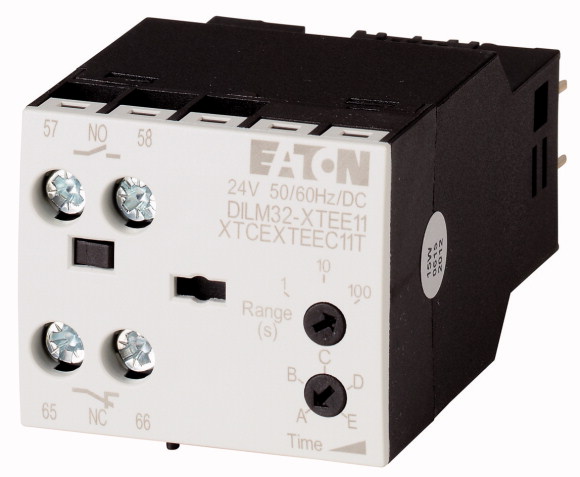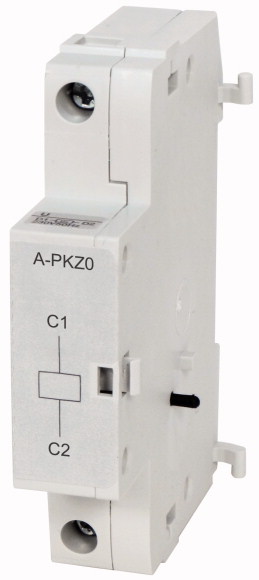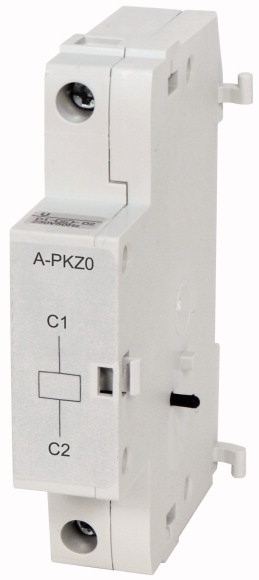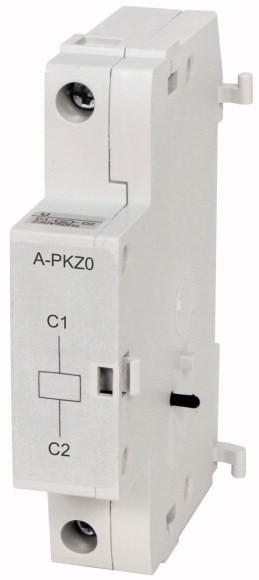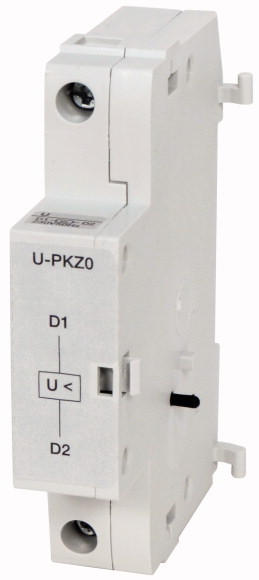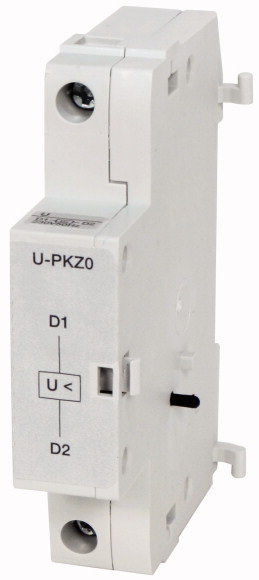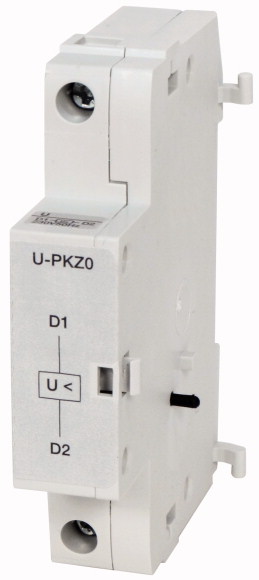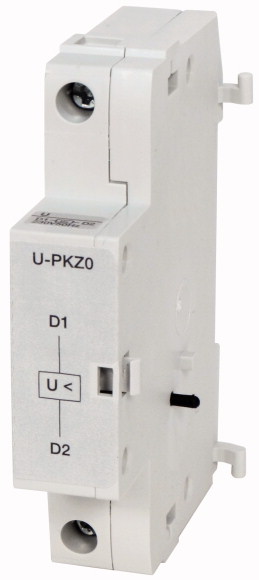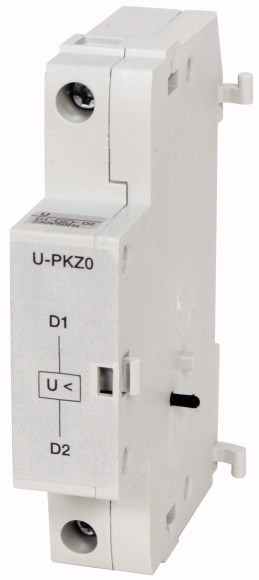| Product range |
Accessories |
| Accessories |
Timer modules |
| Description |
For star-delta applications
Cannot be combined with top mounting auxiliary contacts
Incl. suppressor circuits |
| US |
200 - 240 V AC 50/60 Hz |
| Time range |
Changeover time
1 - 30 s
Changeover delay
50 ms |
| For use with |
DILM7 - DILM38
DILMP20
DILMP32-DILMP45
DILA
DILMF7
DILMF11
DILMF14
DILMF25
DILMF32 |
| Contact sequence |
 |
| Standards |
|
Lifespan, mechanical
>AC operated [Operations] |
DIN EN 61812, IEC/EN 60947, VDE 0660, UL, CSA |
Lifespan, mechanical
>DC operated [Operations] |
3 x 106
|
| Climatic proofing |
3 x 106
|
Ambient temperature
>Open |
Damp heat, constant, to IEC 60068-2-78
Damp heat, cyclic, to IEC 60068-2-30 |
Ambient temperature
>Enclosed |
-25 - +60 °C |
Ambient temperature
>Storage |
- 25 - 40 °C |
| Mounting position |
- 40 - 80 °C |
Mechanical shock resistance (IEC/EN 60068-2-27)
>Half-sinusoidal shock, 10 ms
>N/O contact |
As required, except suspended |
Mechanical shock resistance (IEC/EN 60068-2-27)
>Half-sinusoidal shock, 10 ms
>N/C contact |
6 g |
| Degree of Protection |
6 g |
| Protection against direct contact when actuated from front (EN 50274) |
IP20 |
| Weight |
Finger and back-of-hand proof |
Terminal capacities
>Solid |
0.08 kg |
Terminal capacities
>Flexible with ferrule |
1 x (0.75 - 2.5)
2 x (0.75 - 1.5) mm2 |
Terminal capacities
>Solid or stranded |
1 x (0.75 - 1.5)
2 x (0.75 - 1.5) mm2 |
| Terminal screw |
18 - 14 AWG |
| Pozidriv screwdriver |
M3.5 |
| Standard screwdriver |
2 Size |
| Max. tightening torque |
0.8 x 5.5
1 x 6 mm |
| Rated impulse withstand voltage [Uimp] |
1.2 Nm |
| Overvoltage category/pollution degree |
|
| Rated insulation voltage [Ui] |
4000 V AC |
| Rated operational voltage [Ue
] |
III/3 |
Rated operational current [Ie
]
>AC-15
>220 V 230 V 240 V [Ie] |
250 V AC |
Rated operational current [Ie
]
>DC-13
>DC-13 L/R - 15 ms
>Contacts in series:
>1 [24 V] |
250 V |
Rated operational current [Ie
]
>DC-13
>DC-13 L/R - 15 ms
>Contacts in series:
>1 [60 V] |
3 A |
Rated operational current [Ie
]
>DC-13
>DC-13 L/R - 15 ms
>Contacts in series:
>1 [110 V] |
1 A |
Rated operational current [Ie
]
>DC-13
>DC-13 L/R - 15 ms
>Contacts in series:
>1 [220 V] |
0.2 A |
Rated operational current [Ie
]
>DC-13
>DC L/R ≦ 50 ms
>Contacts in series:
>1 [24 V] |
0.2 A |
Rated operational current [Ie
]
>DC-13
>DC L/R ≦ 50 ms
>Contacts in series:
>1 [60 V] |
0.1 A |
Rated operational current [Ie
]
>DC-13
>DC L/R ≦ 50 ms
>Contacts in series:
>1 [110 V] |
1 A |
Rated operational current [Ie
]
>DC-13
>DC L/R ≦ 50 ms
>Contacts in series:
>1 [220 V] |
0.2 A |
Rated operational current [Ie
]
>DC-13
>DC-13 L/R - 300 ms
>Contacts in series:
>1 [24 V] |
0.2 A |
Rated operational current [Ie
]
>DC-13
>DC-13 L/R - 300 ms
>Contacts in series:
>1 [60 V] |
0.1 A |
Rated operational current [Ie
]
>DC-13
>DC-13 L/R - 300 ms
>Contacts in series:
>1 [110 V] |
1 A |
Rated operational current [Ie
]
>DC-13
>DC-13 L/R - 300 ms
>Contacts in series:
>1 [220 V] |
0.2 A |
Safe isolation to EN 61140
>between coil and auxiliary contacts |
0.2 A |
Safe isolation to EN 61140
>between the auxiliary contacts |
0.1 A |
| Conventional thermal current [Ith
] |
250 V AC |
Short-circuit rating without welding
>max. fuse |
250 V AC |
Voltage tolerance
>Pick-up voltage
>AC operated [Pick-up]0.85 - 1.1 x Uc
Voltage tolerance
>Pick-up voltage
>DC operated [Pick-up] [Pick-up] 0.7 - 1.2 x Uc
Power consumption
>60 °C [Sealing] |
4 A |
Power consumption
>AC operated [Sealing] |
4 A gG/gL |
| duty factor |
|
Maximum operating frequency
>Max. operating frequency |
0.85 - 1.1 x Uc
|
Maximum operating frequency
>Can be combined with auxiliary contact |
0.7 - 1.2 x Uc
|
Conventional thermal current Ith = Ie AC-1
>On-delayed |
2 VA |
Conventional thermal current Ith = Ie AC-1
>Off-delayed |
1.8 W |
| AC operated 50 Hz [Deviation] |
100 % DF |
| Recovery time (after 100% time delay) |
3600 Ops/h |
contact changeover time
>DILM32-XTEE11/DILM32-XTED11 [tu] |
360 Ops./h |
contact changeover time
>DILM32-XTEY20 [tu] |
< 50 ms |
| Notes |
< 200 ms |
Auxiliary contacts
>Pilot Duty
>AC operated |
< 5 % |
Auxiliary contacts
>Pilot Duty
>DC operated |
70 ms |
Auxiliary contacts
>General Use
>AC |
10 ms |
Auxiliary contacts
>General Use
>AC |
50 ms |
Auxiliary contacts
>General Use
>DC |
|
Auxiliary contacts
>General Use
>DC |
For rated operational current: Making and breaking conditions to DC-13, L/R constant as stated
Max. fuses for short-circuit protection: Transparent overlay "Fuses" for time/current characteristics (please enquire)
For pick-up voltage, DC operated:Pure DC, AC bridge rectifier or smoothed double-wave rectification. |
Short Circuit Current Rating
>Basic Rating
>SCCR |
|
Short Circuit Current Rating
>Basic Rating
>max. Fuse |
B300 |
Short Circuit Current Rating
>Basic Rating
>max. CB |
R300 |
Short Circuit Current Rating
>480 V High Fault
>SCCR (fuse) |
240 V |
Short Circuit Current Rating
>480 V High Fault
>max. Fuse |
5 A |
Short Circuit Current Rating
>480 V High Fault
>SCCR (CB) |
24 V |
Short Circuit Current Rating
>480 V High Fault
>max. CB |
5 A |
Short Circuit Current Rating
>600 V High Fault
>SCCR (fuse) |
5 kA |
Short Circuit Current Rating
>600 V High Fault
>max. Fuse |
125 A |
Short Circuit Current Rating
>600 V High Fault
>SCCR (CB) |
125 A |
Short Circuit Current Rating
>600 V High Fault
>max. CB |
10/100 kA |
| Rated operational current for specified heat dissipation [In] |
125/70 Class J A |
| Heat dissipation per pole, current-dependent [Pvid] |
10/65 kA |
| Equipment heat dissipation, current-dependent [Pvid] |
50/32 A |
| Static heat dissipation, non-current-dependent [Pvs] |
10/100 kA |
| Heat dissipation capacity [Pdiss] |
125/125 Class J A |
| Operating ambient temperature min. |
10/22 kA |
| Operating ambient temperature max. |
50/32 A |
10.2 Strength of materials and parts
>10.2.2 Corrosion resistance |
|
10.2 Strength of materials and parts
>10.2.3.1 Verification of thermal stability of enclosures |
0 A |
10.2 Strength of materials and parts
>10.2.3.2 Verification of resistance of insulating materials to normal heat |
0 W |
10.2 Strength of materials and parts
>10.2.3.3 Verification of resistance of insulating materials to abnormal heat and fire due to internal electric effects |
0 W |
10.2 Strength of materials and parts
>10.2.4 Resistance to ultra-violet (UV) radiation |
1.8 W |
10.2 Strength of materials and parts
>10.2.5 Lifting |
0 W |
10.2 Strength of materials and parts
>10.2.6 Mechanical impact |
-25 °C |
10.2 Strength of materials and parts
>10.2.7 Inscriptions |
+60 °C |
| 10.3 Degree of protection of ASSEMBLIES |
|
| 10.4 Clearances and creepage distances |
Meets the product standard´s requirements. |
| 10.5 Protection against electric shock |
Meets the product standard´s requirements. |
| 10.6 Incorporation of switching devices and components |
Meets the product standard´s requirements. |
| 10.7 Internal electrical circuits and connections |
Meets the product standard´s requirements. |
| 10.8 Connections for external conductors |
Meets the product standard´s requirements. |
10.9 Insulation properties
>10.9.2 Power-frequency electric strength |
Does not apply, since the entire switchgear needs to be evaluated. |
10.9 Insulation properties
>10.9.3 Impulse withstand voltage |
Does not apply, since the entire switchgear needs to be evaluated. |
10.9 Insulation properties
>10.9.4 Testing of enclosures made of insulating material |
Meets the product standard´s requirements. |
| 10.10 Temperature rise |
Does not apply, since the entire switchgear needs to be evaluated. |
| 10.11 Short-circuit rating |
Meets the product standard´s requirements. |
| 10.12 Electromagnetic compatibility |
Does not apply, since the entire switchgear needs to be evaluated. |
| 10.13 Mechanical function |
Does not apply, since the entire switchgear needs to be evaluated. |
| Switching function |
Is the panel builder´s responsibility. |
| Setting time |
Is the panel builder´s responsibility. |
| Number of contacts as normally open contact |
Is the panel builder´s responsibility. |
| Number of contacts as normally closed contact |
Is the panel builder´s responsibility. |
| Number of contacts as change-over contact |
Is the panel builder´s responsibility. |
| Operating principle |
The panel builder is responsible for the temperature rise calculation. Eaton will provide heat dissipation data for the devices. |
| Product Standards |
Is the panel builder´s responsibility. The specifications for the switchgear must be observed. |
| UL File No. |
Is the panel builder´s responsibility. The specifications for the switchgear must be observed. |
| UL Category Control No. |
The device meets the requirements, provided the information in the instruction leaflet (IL) is observed. |
| CSA File No. |
|
| CSA Class No. |
|
| North America Certification |
Other |

